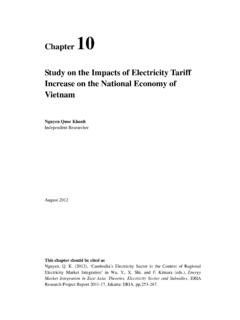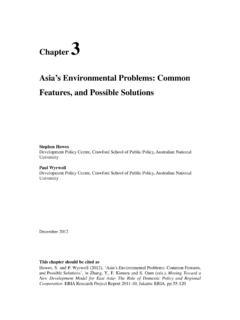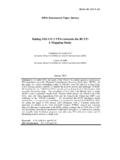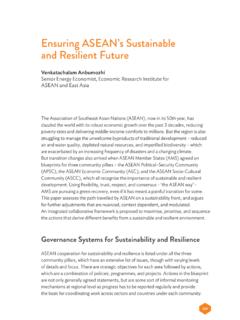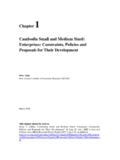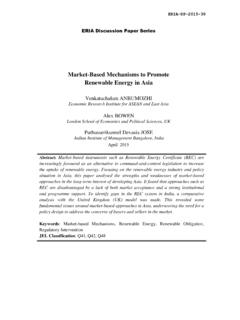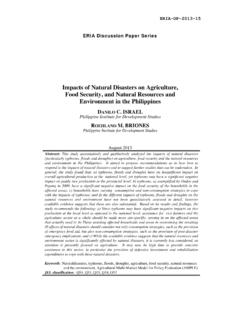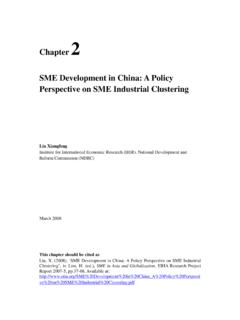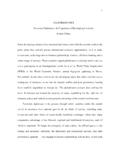Transcription of ASEAN and the Changing Regional Order: The ARF, …
1 146 ASEAN and the Changing Regional order : The ARF, ADMM, and ADMM-PlusAlice D. BaProfessor of Political Science and International Relations, University of Delaware, United StatesIntroductionAmongst the more notable developments in the construction of Regional order in Asia has been the extension of Association of Southeast Asian Nations ( ASEAN ) processes beyond its original Southeast Asian purview, resulting in frameworks and cooperative platforms that are inclusive of not just Southeast Asian states but also larger states in a broader Asia. As prominent pieces of a larger and still evolving Regional security architecture, the ASEAN Regional Forum (ARF) and, more recently, the ASEAN Defense Ministers Meeting (ADMM) and ASEAN Defense Ministers Plus (ADMM Plus), along with other frameworks in economic and other issue domains, additionally provide good illustrations of how ASEAN s small to middle powers have attempted to exercise voice and influence over an evolving Regional order .
2 As ASEAN passes its half-century mark, however, intensified geopolitical tensions and political challenges also test ASEAN frameworks and ASEAN states in old and new ways. This is to say nothing of the questions that have long followed the organisation and its processes as regards its strategic and instrumental efficacy. This paper considers the following question: in what ways are the ARF, ADMM, and ADMM Plus both reflections of, and contributors to, Asia s Changing Regional order and security architecture? As elaborated below, debates and questions about Asia s Regional institutions what they look like; how they should work; what they should prioritise are themselves manifestations of, even proxies for, larger debates about Regional order ; not just who should have pride of place, but also what should be its organising principles.
3 Indeed, a focus on Regional institutions is especially helpful in shedding light on the complexity and multidimensionality of Regional order . 147 ASEAN and the Changing Regional order : The ARF, ADMM, and ADMM-PlusAlice D. BaProfessor of Political Science and International Relations, University of Delaware, United StatesThe rest of this paper proceeds as follows. Beginning first with a brief discussion of the geopolitical space from which ASEAN s Regional institutions emerged, the paper considers the ARF and ADMM/ADMM Plus frameworks as platforms from which states and especially ASEAN states have negotiated the content and structure of Regional order , as well as specific cooperative initiatives.
4 In that the security institutions in question also emerged at distinctly geopolitical moments, they also each offer windows on larger geopolitical changes in train, Changing Regional expectations, and ASEAN s relationship to East Asia s still evolving Regional order . The ARF and ASEAN CentralityThe ARF, ADMM, and ADMM-Plus frameworks have all emerged in a post-Cold War space created by Changing great power policies and realities. The three institutions, however, enter into different geopolitical and institutional moments in the ongoing construction of Regional order in Asia. The ARF emerged in the immediate post-Cold War period a time distinguished by heightened questions about a range of United States (US) commitments in Southeast Asia; a time when China s material capacities and its integration into existing Regional security and economic networks were relatively limited; and a time when there existed no track record of Regional institutions or security cooperation outside of ASEAN in East Asia.
5 In contrast, the ADMM and ADMM-Plus frameworks were created 12 and 16 years later in a vastly different geopolitical and institutional setting characterised by the growing capacities of China, heightened economic and security interdependence amongst states, and also multiple, overlapping, and sometimes competing institutional frameworks and in which ASEAN is both more influential and more questioned as a Regional actor. As regards the underlying bases for Regional order , the ARF may be considered the more significant moment and development. As the first of ASEAN s expanded cooperative frameworks and first official-level, track-one Asia Pacific security dialogue, the ARF introduced to the East Asian security policy debate alternative cooperative security conceptualisations that would form the basis for a more comprehensive and inclusive approach to security.
6 In particular, cooperative security extends security beyond conventional deterrence to issues of comprehensive and sustainable development in all fields, inclusive of domestic-developmental, external security, and interdependent nontraditional security arenas (Caballero Anthony, 1995). Premised on principles of inclusivity, cooperative security also prioritises reassurance objectives and consequently gives greatest emphasis to mechanisms of dialogue, consensus, and confidence building over more task-oriented problem solving and more confrontational forms of security management. 148 ASEAN @14 Volume 6 | Building ASEAN Community: Political Security and Socio-cultural ReflectionsDefined thusly, the cooperative security conceptualisations underlying the ARF are what also justifies a broadly inclusive membership.
7 Just as important, cooperative security s inclusivity principle provides the basis for alternative organising hierarchies in this specific case, a more influential, even leading, role for ASEAN s group of smaller powers. In other words, just as security conceptualisations defined as balance of power privileges the most conventionally capable (namely, the larger powers), cooperative security based on principles of inclusivity privileges those best able to facilitate a coming together of different states or what some call convening power (Stubbs, 2014). The ARF offered an early institutional expression of what is now commonly referred to as ASEAN centrality.
8 The ARF s cooperative security approach also offered a particular contrast to the more exclusive, oppositional approaches associated especially with US military alliances, which until the early 1990s offered the only set of arrangements responding to the broader purpose of Regional security . Given the inclusion of the US, the ARF by no means negated or replaced more conventional major power security contributions; but the ARF did represent an important first effort to diversify security options beyond the US, whose security role was itself viewed as insufficiently reliable and often deeply More significantly, cooperative security contrasts with US alliance strategies in its most basic premise, which is that security is best gained not by working against others, but rather working with them.
9 In this vein, ASEAN states insistence on Chinese participation may be considered more significant than US participation, especially given emergent concerns about a rising China in post-Cold War East Asia. The concern for mutual security also offers additional justification for ASEAN s consensus-driven approach to Regional security, though consensus mechanisms in the ARF also serve the additional purpose of institutionalising a regard for the interests of ASEAN s smaller states vis- -vis larger Thus, the inclusivity of the ARF its distinctively omni-inclusive, multilateral engagement of all larger powers and its justifying rationale for both the principles and mechanisms of ASEAN centrality remain its most stand-out features.
10 But it is also these very features that today make the ARF the most contested of ASEAN s institutions. In particular, inclusion has made for a large and diverse set of actors and interests (now 27 members in all) that disagree about both the whats and the hows of Regional security. Meanwhile, ASEAN centrality has been challenged by the constraints of consensus, as well as collective ASEAN s limited ability to move cooperation forward. 1 See discussions in Capie (2004) and Bates et al. (2009).2 See, for example, discussions in Khong and Nesadurai (2007) and Wesley (2003).149 ASEAN and the Changing Regional order : The ARF, ADMM, and ADMM-PlusAs conceived, the ARF s institutionalisation of security cooperation was supposed to move through three stages confidence building, preventive diplomacy, and elaboration of approaches to conflict.
